Features and types of axes
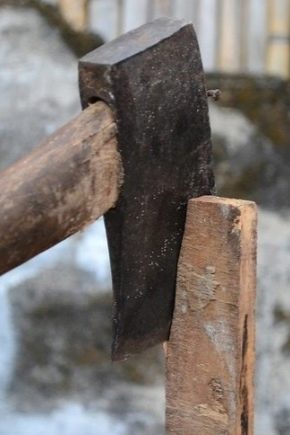
The ax is a unique tool that, despite its simplicity, is very versatile. This tool is widely used in everyday life. You cannot do without it in the country, on a camping trip, on vacation. Uncomplicated design, ease of use, a wide range of models make the ax very popular even in our progressive age.
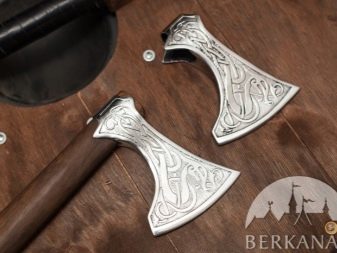
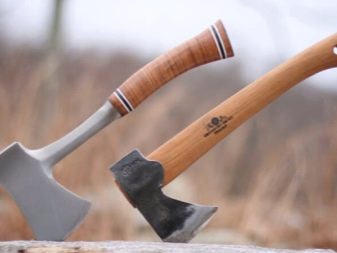
What it is?
An ax is a tool that is used for chopping. It is just a weighty metal blade, which is attached by attaching it to the handle. It is worth noting that, if necessary, the handle can be easily changed to a new one. This makes the ax even more convenient to use.
This instrument has been known since ancient times. True, then it was stone, but over time it has significantly changed. In ancient times, the ax often played the role of cold or throwing weapons. Later, it began to be used mainly in everyday life. Nowadays, the ax is most often used for various woodworking.

Specifications
Axes are distinguished by a number of characteristics. Among them, the weight of the tool is in the first place. This parameter varies quite a bit.
The smallest tool weight is 0.9 kg. Most often, axes with a low weight are difficult to find use. Of course, they are convenient on a tourist vacation. But even there it is difficult to get decent firewood with them. These axes are only suitable for sharpening stakes when setting up tents.
The best choice is implements weighing between 1 kg and 1.7 kg. This mass allows you to cut trees of medium thickness with one hand. In addition, the tool is comfortable to work with. Axes that are too large do not allow working for a long time or making a good swing. In addition to chopping wood, axes with this weight are used for various works in the construction and woodworking industries.
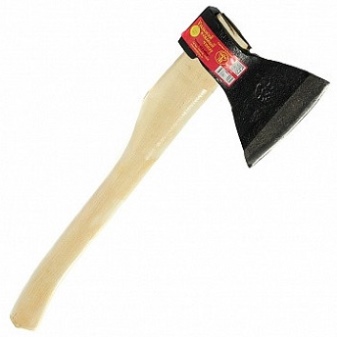
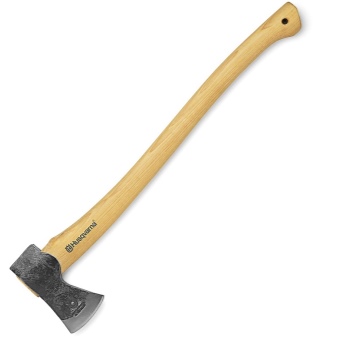
Of course, when you need to split a tree, a heavy cleaver is the best option. Typically, these tools have a weight of 2 to 2.5 kg. The special dimensions with the elongated ax handle make it possible to hit the tree with greater force. These models are best used with two hands. Axes can also vary widely in blade shape and quality. Of course, it is better to opt for the highest quality options possible. It is this parameter that shows how long the service life of the tool will be. Also, the quality of the blade directly affects its sharpening. Choosing a good tool, you do not have to worry about chips and various damages on the blade.
With direct sharpening with an ax, you can cut it with high quality, delivering accurate and strong blows. As for the curved shape, it makes it possible not only to cut, but also to make stabbing movements. The rounded shape of the blade and the small size allow deep penetration into wood. Also, with such an ax, you can chop fibers not only in the longitudinal, but also in the transverse direction.
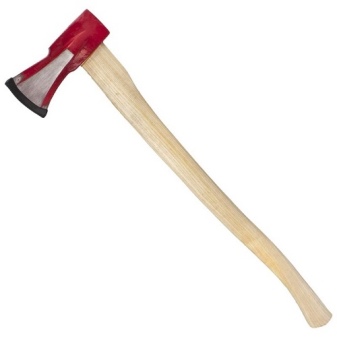

The blades are made different depending on how they will be used. For example, carpentry axes are made in such a way that it is convenient for them to handle boards, logs and various wood blanks. However, this tool is completely unsuitable for cutting whole trees and large branches.For these tasks, there are other more convenient axes with a rounded blade.
Too dense wood will be handled by a very specific tool, which is called the taiga ax. Its blade is located at a fairly sharp angle relative to the tool (carpentry or used for chopping).
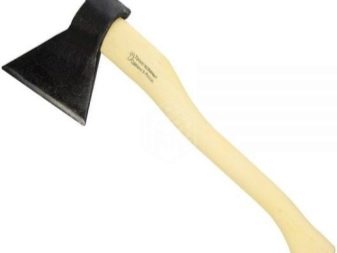

Axes can also differ in the type of butt. Practice shows that there are 3 main types of butt:
- narrow is necessary in order to perform neat work, including carpentry;
- medium is versatile and most common to use;
- wide is suitable for tools used to cut wood.
For the handle of an ax, it is very important how it will lie in the hand. If it is too small or large, then it will be difficult and not very pleasant to work with such a tool. Do not choose grips that have bumps or notches.
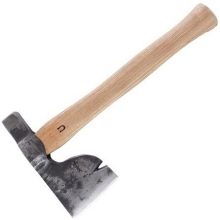
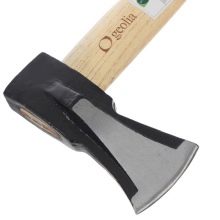
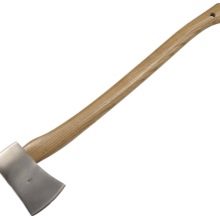
The length of the handle deserves no less attention. For a large impact force, it is required that it be long. However, if precise strikes are required, it is worth opting for models with a short handle. For example, lumberjacks prefer an ax that is no more than 90 cm long.
Another important characteristic of the ax is the way in which the head is mounted on the ax. Practice shows that most often the ax is mounted on the handle with a hole in the blade, and then fixed with a wedge.
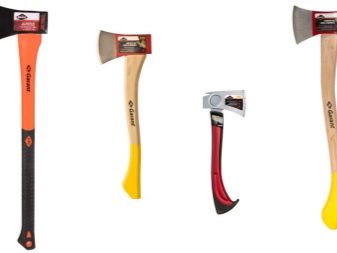
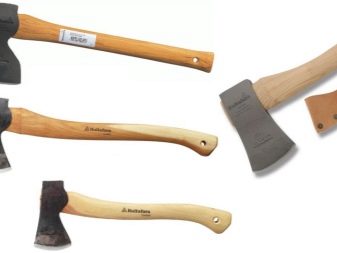
What does it consist of?
The ax is a very simple tool that includes only three parts.
- The blade, made of metal, is the main part. It depends on him how long the ax will serve, as well as how good it will be at work.
- The ax or handle is in second place in importance. Of course, a lot also depends on what this part will be.
- A wedge is also distinguished among the parts of the ax. How well it is made, as well as how it fits with other parts, will determine the integrity of the entire instrument.
Axemen recently are unlikely to notice more than these three parts. However, professionals single out a few more. Among them is the butt, which is understood as the knob on the blade. You can also highlight the sock, beard and notch, which can be very different for each individual instrument model.

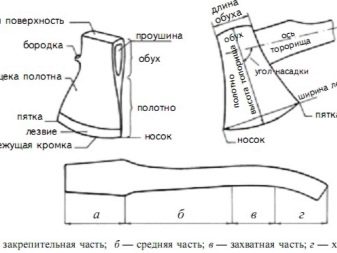
Handle material classification
Sometimes, even with an excellent blade, the ax does not do its job as well as we would like. In this case, you should pay attention to the hatchet. It largely depends on how effective the tool will be. Of course, first of all, one should take into account the material from which the handle is made.
Metal
The metal hatchet looks very impressive, especially on large models of blades. However, at first glance, durable material is not the best for the handle. This is due to the fact that vibration is poorly damped. Therefore, it is best to choose models of axes that have a special pad, preferably made of rubber. They are capable of improving this type of handle.
Of course, among these pens there are very beautiful and original options. You can also order an ax just for yourself. Many are especially interested in forged models.
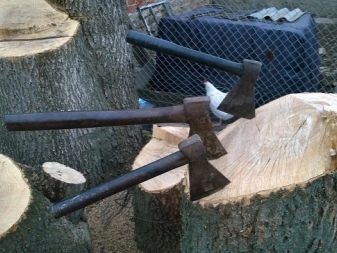
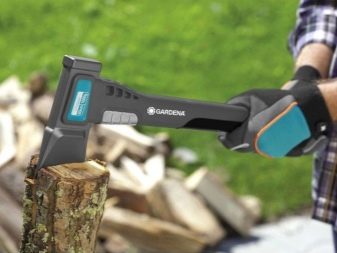
Plastic
Plastic ax handles are quite common. The main disadvantage, as with the metal versions, is poor vibration damping. That is why they also have to be used with a pad that can somewhat reduce vibration. Unlike other materials, plastic axes are more fragile and require certain storage conditions.
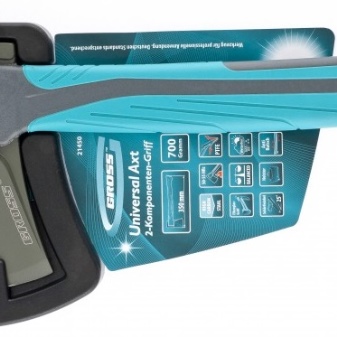
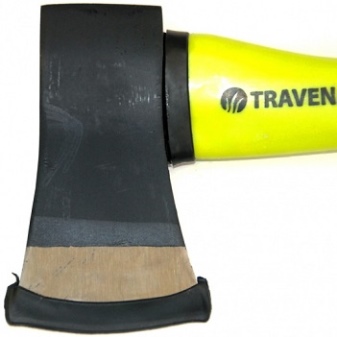
Wood
The best and most common are the wood-based axes. Such a handle is capable of completely absorbing the force of impact and resistance of the workpiece. The most common wood used to make these elements is birch. However, it should be borne in mind that such an ax will cost a lot.Pine handles do not deal well with vibration, but their cost makes them more affordable.
Of course, oak handles are best for the axes used by lumberjacks. Among the advantages of wooden hatchets should be noted lightness, ease of replacement, maintenance, attachment to the blade, as well as a wide variety.
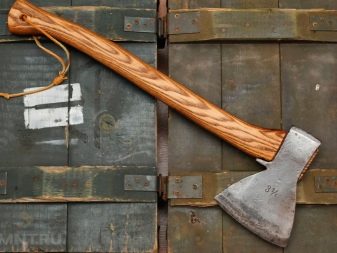
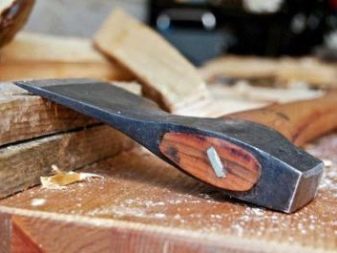
Types and purpose
Axes are divided into several types depending on the purpose. This allows you to speed up the choice and better understand which tool is needed for every day, and which one is suitable for a special occasion, for example, for hunting, fishing, travel.
Economic
Most often, the household uses an ax for chopping wood. For these purposes, options with a sharpening of about 50 degrees are excellent. Ideal if the blade is made of hardened steel and the handle is made of wood. A modern ax of this type is distinguished by its simplicity and efficiency. The optimal weight of such an ax is up to 1 kg.
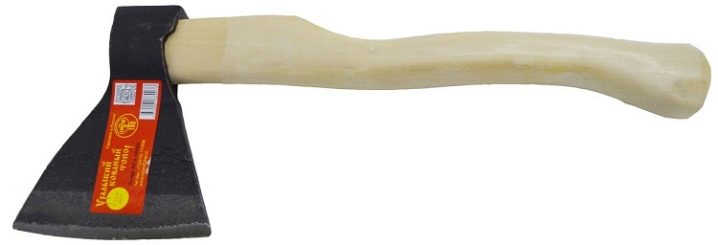
Plotnitsky
A carpenter's or joiner's hatchet has a straight sharpening, and its weight does not exceed 0.9 kg. The length of the ax is small - about 0.5 meters. The blade is thin and very well sharpened. Today, such an ax most often helps to solve construction problems. For example, they make grooves in the logs during the construction of log cabins.
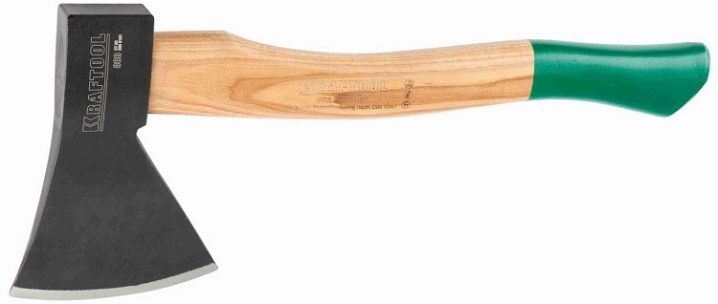
Bilateral
This type has two high-carbon steel blades at once. Both are imprisoned. The tool is characterized by precise balancing. Often, such an ax is sharpened more thinly on one side than on the other. This allows the tool to be used for a variety of tasks. Also, the double ax can be used as a throwing weapon.

For the forest
The main difference between a felling ax is its heavy weight. This allows you to strengthen the blow. It is not suitable for other tasks. It is also important for this type that it has a long handle and a rounded blade made of high strength steel. A heavy tool can only be used with two hands.

Cleaver
The peculiarity of this type is its high weight (from 2 kg) and a long handle (from 0.8 meters). Despite the fact that such a tool does not have a sharp edge, it easily splits large logs. They work with a cleaver exclusively with two hands.
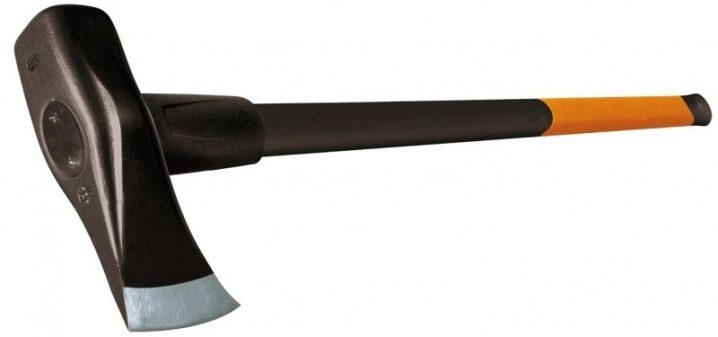
Tourist
For a tourist, the best option is a small hatchet, which is notable for its low weight. Rarely are instruments of this type weighing more than 0.6 kg. The touring ax can be foldable, making it even more convenient. As a rule, such products are sold immediately in covers.
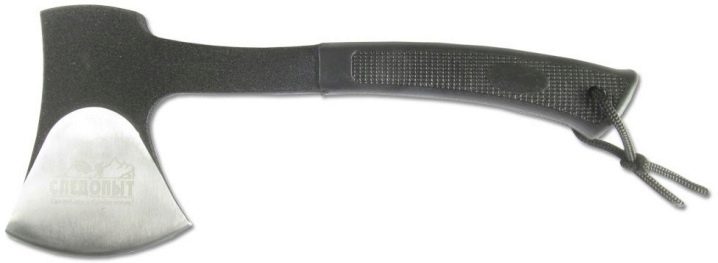
Marching
The main differences of this variety are versatility, small size and low weight. Quite often, these models come with rounded blades, which makes them safer to carry in a backpack or bag. Be sure to include a cover for such an ax. With such a tool, you can chop wood, and butcher meat, and hammer a peg.
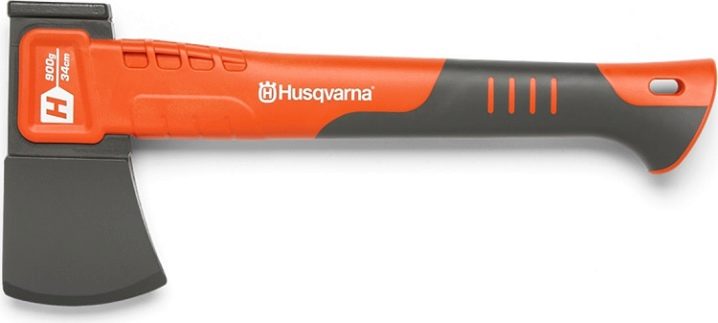
Hunting
This type is fighting, although it is more often used as decoration for interiors. Often such models are all-metal with patterns on the blade. The weight of the tool does not exceed 1 kg, and the length is up to 0.5 meters. A hunting ax is equally well suited for butchering carcasses and chopping branches. Exclusive options are often found among models of this type.
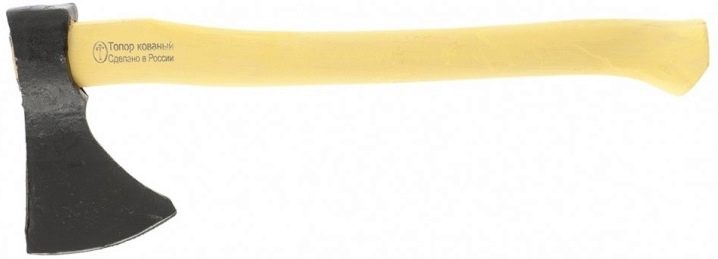
Butcher's ax
Professional iron tools are often cast from high-strength steel. It is distinguished by a rather impressive weight and sharpening at an acute angle. The wide blade allows you to chop meat effortlessly.
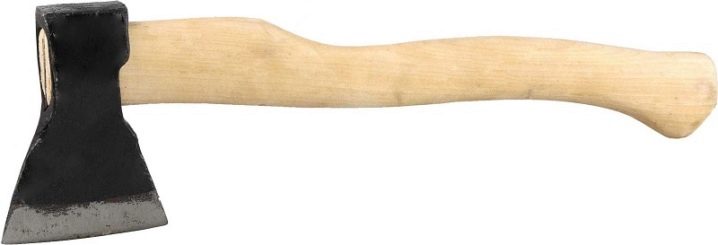
Subtleties of choice
Before choosing an ax, you should decide what it will be used for. For joiners and carpenters, there are special models with a straight chopping part. But for splitting logs you need a powerful cleaver. You can cut down a tree if you have a heavy lumberjack ax with a long handle and a rounded blade. A garden or hiking ax should be light, comfortable and small.
You need to understand that it is better to cut down large trees or cut large logs with wide axes, which have a very impressive weight. Medium axes should be used for chopping wood, sharpening stakes, and most other daily tasks. But narrow axes are needed where very precise work is required (for example, if you need to remove knots, chop wood chips, and so on). They are often used as hammers.
When buying, it is important to check how the hole in the butt expands. This moment is important in order to properly wedge the handle in the head of the instrument. You should also check the parallelism of the blade with the line of symmetry of the butt. To check the hardening of the steel, hang the tool and then click on the blade. If the ringing is high, it means that the steel is well hardened.
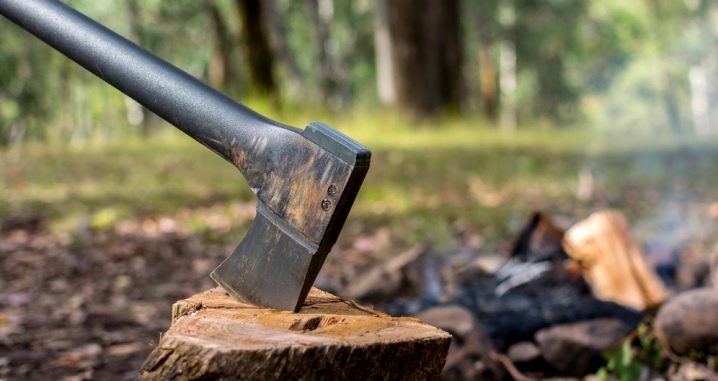
Currently, the variety of models of axes from different manufacturers is quite wide. Instruments from Chinese, American, German, Finnish, Swedish and French firms are presented. Tourists and those who need axes for chopping wood should pay attention to Finnish manufacturers, for example, Bahco. Of course, their cost is rather big, but they offer a high-quality steel blade and an excellent wooden handle.
Another well-known Finnish company - Fiskars offers axes with plastic axes. They feature a ten-year grip guarantee. The manufacturer claims that they do not break. It seems that this is indeed the case, considering the cost and demand for these products. In addition, the blades on Fiskars axes are Teflon coated.
Medium quality axes are offered by German and Swedish manufacturers at appropriate prices. Among them it is worth giving preference to firms Stihl and Husqvarna. But the Chinese axes should be treated with caution. Among the models presented there are both high-quality and inexpensive, and very short-lived options.
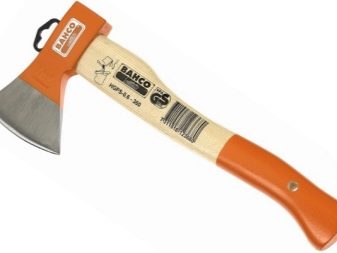
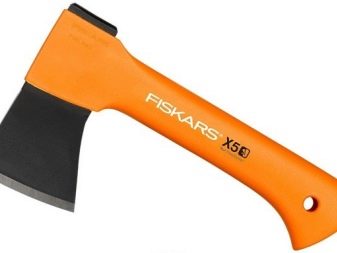
How to use?
If the ax is purchased and fully assembled, you need to take care of its durability. To do this, it is advisable to protect the wood handle from temperature fluctuations, moisture, sunlight, various solvents and oils. To achieve this, you need to soak the handle with special compounds, and then dry it. Impregnation can be carried out with wax, drying oil, linseed oil and other special agents that clog the pores of the wood.
When the ax is completely ready for use, you can start cutting. You need to be able to cut trees with an ax correctly. For example, when cutting down a short tree, it is not necessary to remove the branches first. Tie the rope as close to the top as possible. The side on which the tree is to be dumped must be cut with an ax, and the other side must be sawed off with a saw.
It is best to cut down small trees and shrubs obliquely. As for the preparation of firewood, then this must be done on a deck. From a tree that has already been felled, branches should be removed with an ax, heading from the root to the top. This avoids bullying.


Cutting logs is initially a very challenging task. For felling logs, beams, as well as thick poles, it is best to use a solid support made of wood. Massive logs or volumetric logs are suitable as it. They need to be placed exactly under the place that you plan to chop off.
First, the fibers are cut with sheer blows. In this case, it is advisable to make a preliminary marking. After that, you should chop from the side, approximately at an angle of 45 °. Plumb strikes alternate with oblique ones. Gradually turning the log, you need to move to the middle, preferably evenly on all sides.
For a trick, it is worth doing oblique blows with an ax at an angle. In this case, the workpiece should be rotated so that the necessary sharpening is obtained. It is preferable for this task to keep the left arm as high as possible.This will avoid damage.
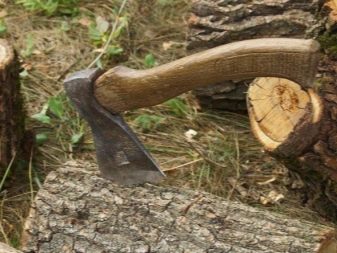

If you need to cut the board, then you should fix one end of it. From the side where the cutting is carried out directly, it is better to set the leg not just to the side, but also a little back. As for the other leg, it should be firmly pressed against the tree. The cutting is done from the top to the bottom. In order to avoid stabbing the wood deeper, it is necessary to make cuts at a distance of 0.4 meters from each other.
In the event that you need to cut a long board, this is done from the bottom up. In this case, cuts are also made along the edge. The wood is cut with an ax little by little towards the other end. When stabbing the board, it is necessary to change the direction of the hanger.
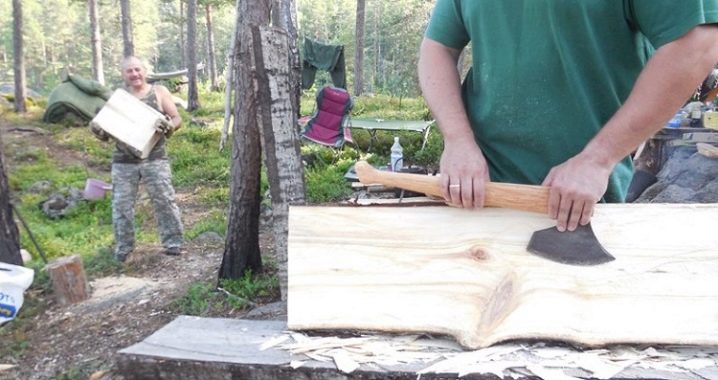
Care rules
If you want the ax to serve for a long time, you should take proper care of it. Broken tools not only impair the quality of work, but also pose a hazard to those who use them. It is very important to ensure that the ax is well planted on the ax. In the event that the handle is broken, it is better to replace it with a new one.
It is important to protect the ax from rust during the rainy season. To do this, it is enough to apply ordinary machine oil to the metal parts. If it was not possible to protect the product, then the tool can be cleaned of rust quickly and easily using special products that are sold in household stores. It is advisable to store the ax in a case, which is often sold immediately complete with it.

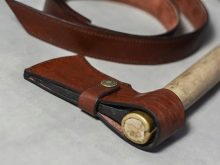
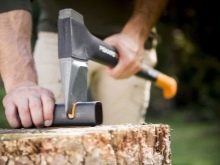
A round sharpener is best suited for sharpening axes, which should be moistened. When sharpening, hold the implement by the butt and the middle of the handle. The sharpening stone must always rotate towards the blade. With a large number of burrs, the cutting edge is leveled with a file. Do not sharpen axes with an electric grinder.
For axes with rounded blades, it is recommended to sharpen the edges at a less sharp angle than the middle. As a result, the tool will not only cut better, but also become less brittle, which will increase its strength when struck with an edge.
For information on how to choose the right ax, see the next video.



































































The comment was sent successfully.